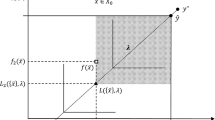Abstract
Quadratic integer programming problems with cardinality constraint have many applications in real life. Portfolio selection is an important application in financial optimization. In this paper we develop an exact and efficient algorithm for quadratic integer programming problems with cardinality constraint. This iterative algorithm is actually a branch and bound method, which adopts a domain cut and partition scheme. Removing cardinality constraint and integrality constraints on variables, the relaxation problem is a quadratic programming problem. By solving the quadratic programming problem, we find a lower bound for the optimal objective function value of the primal problem. The domain cut technique is used to cut off some regions that do not contain any feasible solution better than the incumbent solution. Thus the optimality gap is reduced greatly. The finite number of iterations is clear from the fact that there are only a finite number of feasible integer solutions in the feasible region. Encouraging computational results are also reported in the paper.
Similar content being viewed by others
Notes
min, max and avg stand for minimum, maximum and average results by running the algorithm for 10 test problems; ratio is the ratio of the number of the problems where the cardinality constraint is active to the number of the test problems 10.
References
Bazaraa, M.S., Sherali, H.D., Shetty, C.M.: Nonlinear Programming: Theory and Algorithms. Wiley, New York (1993)
Markowitz, H.: Portfolio selection. J. Financ. 1, 77–91 (1952)
Markowitz, H.: Portfolio Selection: Efficient Diversification of Investment. Wiley, New York (1959)
Hakansson, N.H.: Multi-period mean-variance analysis: toward a theory of portfolio choice. J. Financ. 26, 857–884 (1971)
Li, D., Ng, W.L.: Optimal dynamic portfolio selection: mutiperiod mean-variance formulation. Math. Financ. 10, 387–406 (2000)
Mossin, J.: Optimal multiperiod portfolio policies. J. Bus. 41, 215–229 (1968)
Samuelson, P.A.: Lifetime portfolio selection by dynamic stochastic programming. Rev. Econ. Stat. 51, 239–246 (1969)
Zariphoulou, T.: Investment-consumption models with transactions costs and Marko chain parameters. SIAM J. Control Optim. 30, 613–636 (1992)
Zhou, X.Y., Li, D.: Continuous-time mean-variance portfolio selection: a stochastic LQ framework. Appl. Math. Optim. 42, 19–33 (2000)
Burdett, C.A., Johnson, E.L.: A subadditive approach to solve linear integer programs. Ann. Discret. Math. 1, 117–144 (1977)
Shaw, D.X., Liu, S.C., Kopman, L.: Lagrangian relaxation procedure for cardinality-constrained portfolio optimization. Optim. Methods Softw. 23(3), 411–420 (2008)
Jobst, N.J., Horniman, M.D., Lucas, C.A., Mitra, G.: Computational aspects of alternative portfolio selection models in the presence of discrete asset choice constraints. Quant. Financ. 1, 1–13 (2001)
Bertsimas, D., Shioda, R.: Algorithm for cardinality-constrained quadratic optimization. Comput. Optim. Appl. 43(1), 1–22 (2009)
Cervinka, M., Kanzow, Ch., Schwartz, A.: Constraint qualifications and optimality conditions for optimization problems with cardinality constraints. Math. Program. 160(1–2), 353–377 (2016)
Zheng, X.J., Sun, X.L., Li, D.: Improving the performance of MIQP solvers for quadratic programs with cardinality and minimum threshold constraints: a semidefinite program approach. INFORMS J. Comput. 26(4), 1–14 (2014)
Gao, J.J., Li, D.: Optimal cardinality constrained portfolio selection. Oper. Res. 61(3), 745–761 (2013)
Mansini, R., Speranza, M.G.: Heuristic algorithms for the portfolio selection problem with minimum transaction lots. Eur. J. Oper. Res. 114, 219–223 (1999)
Bonami, P., Lejeune, M.A.: An exact solution approach for portfolio optimization problems under stochastic and integer constraints. Oper. Res. 57(3), 650–670 (2009)
Li, D., Sun, X.L., Wang, J.: Optimal lot solution to cardinality constrained mean-variance formulation for portfolio selection. Math. Financ. 16(1), 83–101 (2006)
Wang, F.L.: A new exact algorithm for concave knapsack problems with integer variables. Int. J. Comput. Math. 96(1), 126–134 (2018)
Li, D., Sun, X.L., Wang, F.L.: Convergent Lagrangian and contour cut method for nonlinear integer programming with a quadratic objective function. SIAM J. Optim. 17, 372–400 (2006)
Author information
Authors and Affiliations
Corresponding author
Additional information
Publisher's Note
Springer Nature remains neutral with regard to jurisdictional claims in published maps and institutional affiliations.
About this article
Cite this article
Wang, F., Cao, L. A new algorithm for quadratic integer programming problems with cardinality constraint. Japan J. Indust. Appl. Math. 37, 449–460 (2020). https://doi.org/10.1007/s13160-019-00403-0
Received:
Revised:
Published:
Issue Date:
DOI: https://doi.org/10.1007/s13160-019-00403-0




